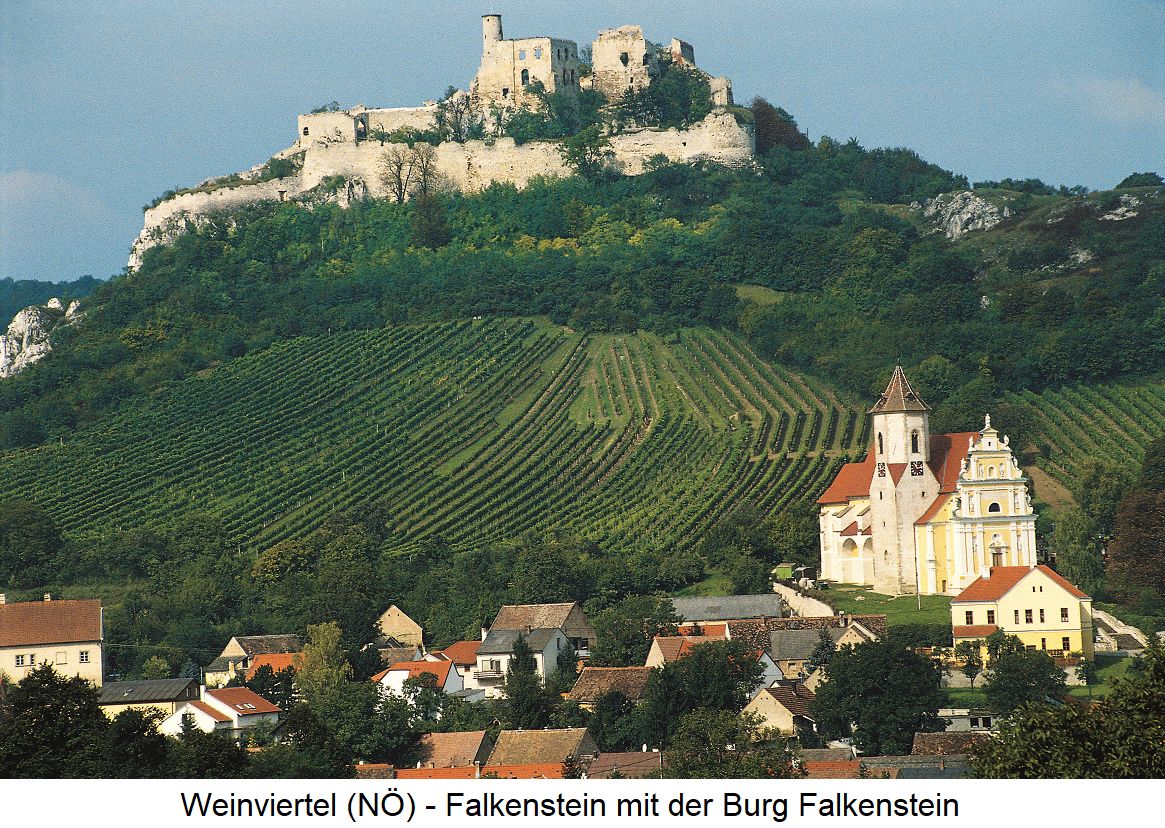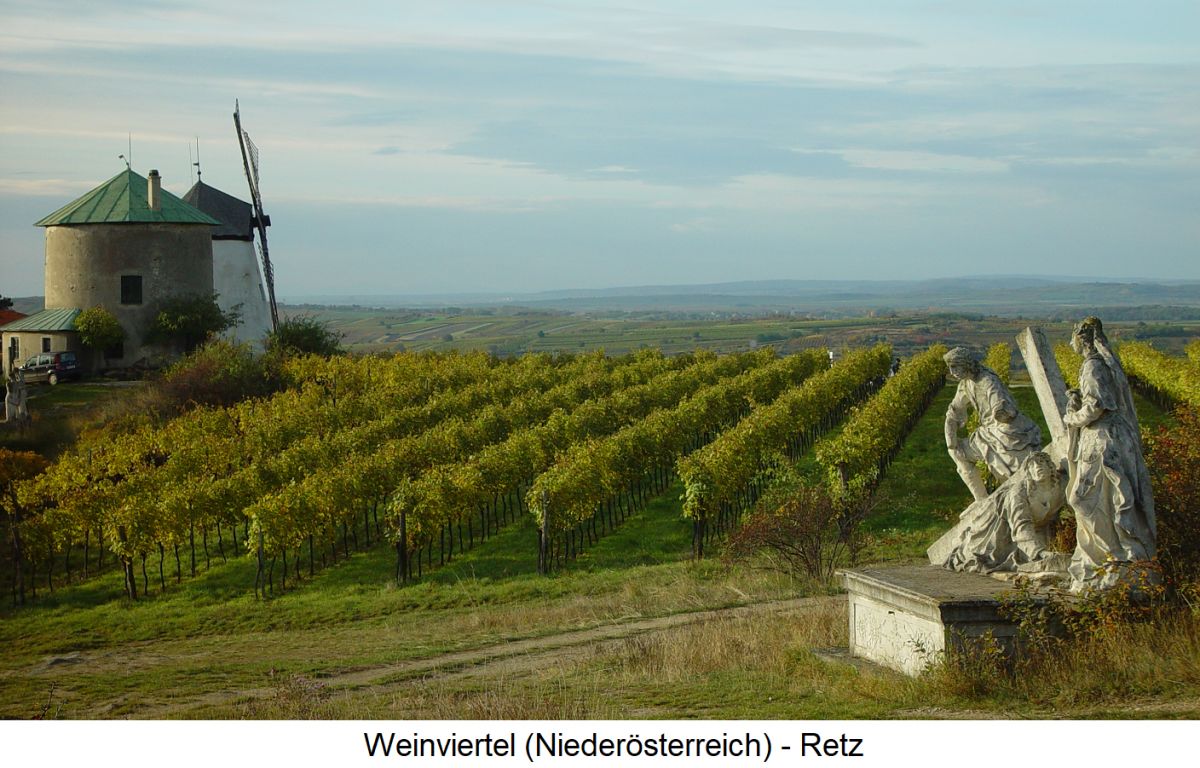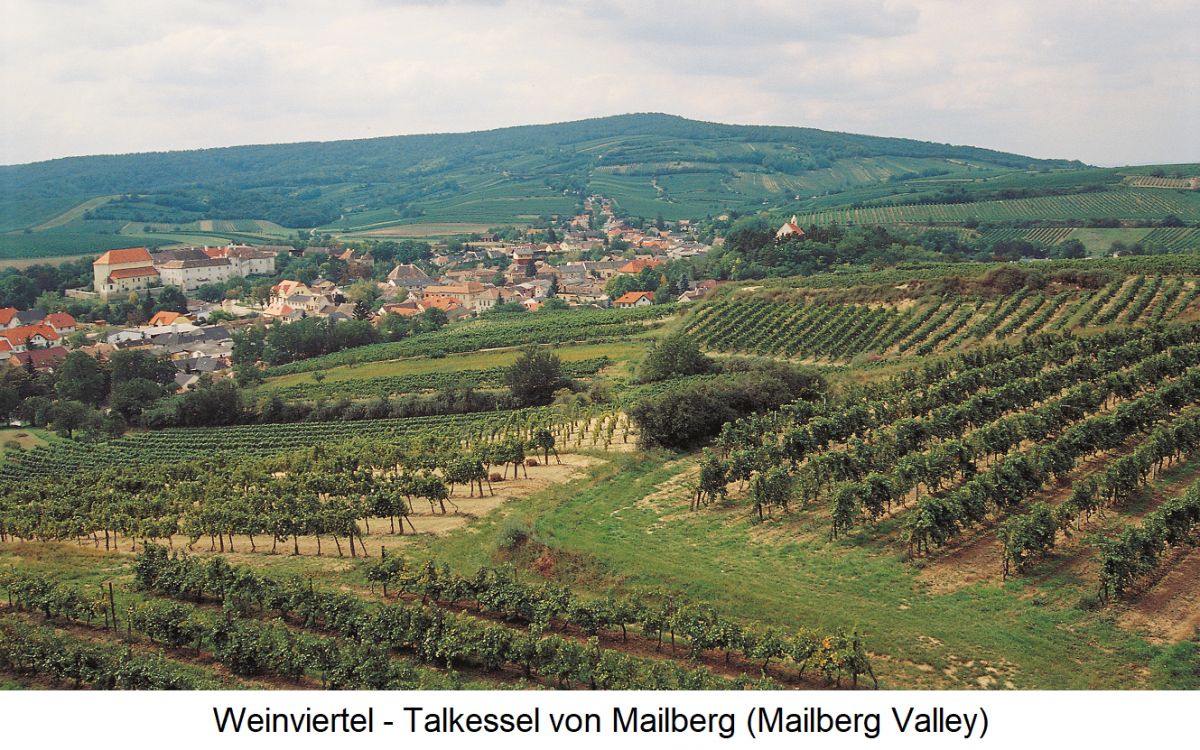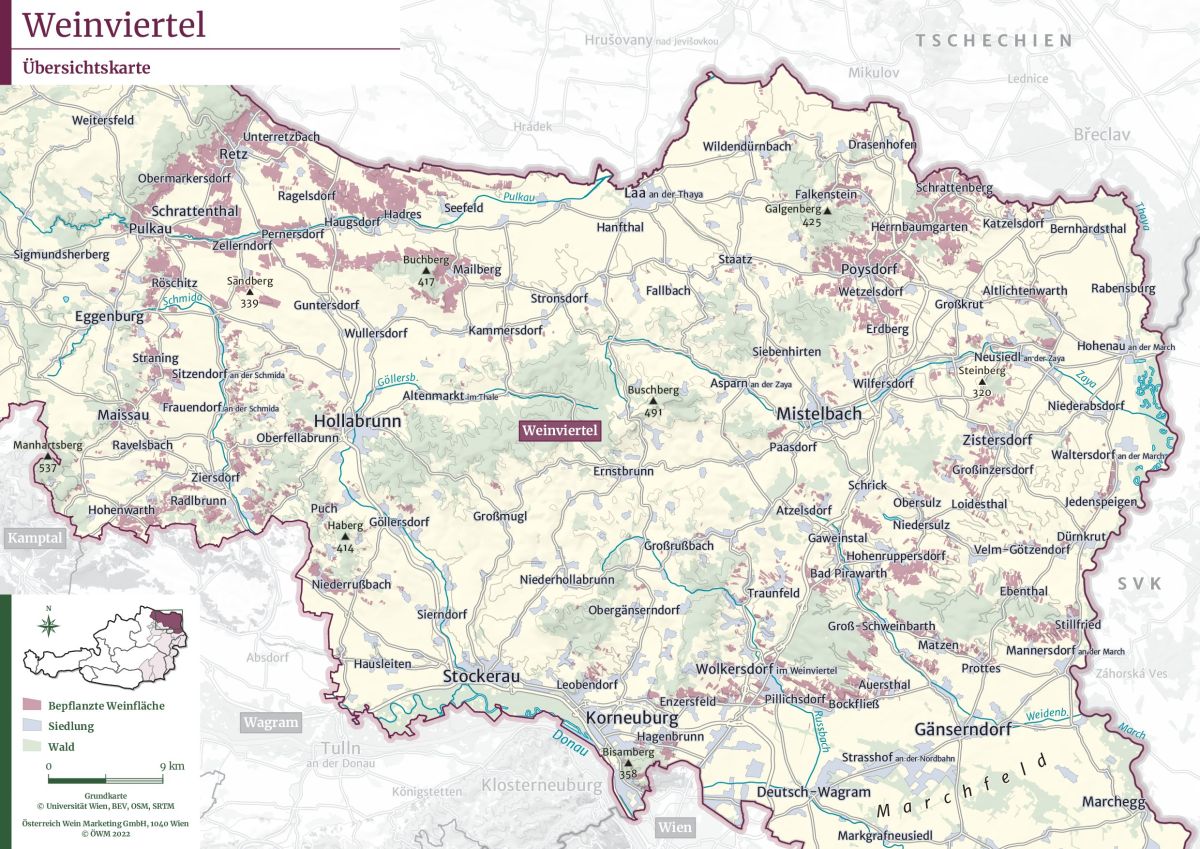Results
2,284 Results
Loading more Results ...
Loading more Results ...
| Weinviertel |
Description to Weinviertel
One of the eight specific wine-growing regions in the Austrian province or generic wine-growing region of Lower Austria. Viticulture was already practised here by the Celts before the birth of Christ. Grape seeds of the cultivated vine Vitis vinifera were found in the municipality of Stillfried, dating back to 900 BC. This makes it one of the oldest wine-growing communities in Central Europe, alongside Zagersdorf in Burgenland. The typical Weinviertel wine is named Brünnerstraßler after an old trade route from Vienna to Brno in the Czech Republic. The gently undulating region north of the Danube borders the Czech Republic in the north and stretches from the Manhartsberg in the west to the border with Slovakia in the east.

Wine-growing areas
The Weinviertel is not a closed area, but consists of many, sometimes small vineyard islands. It used to be divided into three areas. These were Falkenstein, Retz and Mailberg.
Falkenstein
The eastern area Falkenstein begins in the south near Vienna. The most important wine-growing communities with the best-known vineyards are Bisamberg (Gabrissen, Jungenberg, Wiesthalen), Bockfliess, Falkenstein (Alsen, Eckartsberg, Kreuzberg, Rabenstein, Rosenberg), Enzersfeld (Sandtal), Gänserndorf, Herrnbaumgarten, Katzelsdorf, Kleinhadersdorf (Birthal, Bockgärten, Hochenleiten), Korneuburg, Langenzersdorf, Mannersdorf, Matzen, Mistelbach, Münichsthal (Seewansche Lagen), Poysbrunn, Poysdorf (Bürsting, Hermannschachern, Kirchbergen, Saurüsseln, Weiße Bergen), Schrattenberg, Stetten (Haidviertel, Hundsleiten, Mitterviertel, Neuberg, Zeiseneck), Wetzelsdorf, Wolkersdorf and Zistersdorf.

Retz & Mailberg
The area to the west Retz extends from the municipality of Großriedenthal in the south to the eponymous municipality of Retz in the north. The most important wine-growing communities are Eggenburg, Frauendorf, Haugsdorf, Hohenwarth-Mühlbach, Hollabrunn, Kleinhaugsdorf, Limberg, Maissau, Mühlbach am Manhartsberg, Ravelsbach, Retz with Oberretzbach, Mitterretzbach and Unterretzbach (Altenberg, Klafel, Satzen, Züngel), Röschitz, Ruppersthal, Schrattenthal, Sitzendorf and Ziersdorf. The vineyards of the Mailberg with the Hundschupfen vineyard form a very special climatic island.

Climate & Soils
The soil types are very varied due to the very wide area, but loess, loam, primary rock and black earth soils dominate. The climate is continental, with a Pannonian influence only in the far east. Summers are predominantly hot and dry and winters are cold. The vineyards lie between 200 and 250 metres above sea level. The best vineyards are in locations with a particularly favourable microclimate, such as Bisamberg, Falkenstein, Mailberg and Retz. The "Weinviertel Wine Route" was founded in 2001 to promote wine and cultural tourism. Over a length of more than 130 kilometres, 150 municipalities with over 500 wine-growing businesses are involved.

Grape variety index
In 2022, the vineyards covered a total of 13,911 hectares of vines. Compared to 2015 with 13,858 hectares, this was a reduction of 53 hectares (0.4%). The proportion of white wine varieties is 79%, while the proportion of red wine varieties is 21%. The clearly dominant white wine variety Grüner Veltliner accounts for half of the total, which is why the region is also known as "Veltliner country". It is followed by Zweigelt, Welschriesling, Riesling, Müller-Thurgau and Muskateller.
Grape variety
|
in Austria
|
colour |
HA
|
%
|
HA
|
%
|
| Grüner Veltliner | White plum | white | 6.975 | 50 | 6.672 | 48,1 |
| Zweigelt | Blauer Zweigelt, Rotburger | red | 1.840 | 13,2 | 1.638 | 11,8 |
| Welschriesling | - | white | 926 | 6,7 | 1.091 | 7,8 |
| White Riesling | Riesling Rhine Riesling | white | 693 | 5 | 562 | 4,1 |
| Müller-Thurgau | Rivaner | white | 454 | 3,3 | 546 | 3,9 |
| Muscat | Yellow M., Red M. / Muscat Blanc | white | 412 | 3,0 | 170 | 1,2 |
| Pinot Blanc | Pinot Blanc, Klevner | white | 397 | 2,9 | 443 | 3.2 |
| Chardonnay | Morillon - not used in Lower Austria | white | 379 | 2,7 | 271 | 2,0 |
| Blauer Portugieser | - | red | 312 | 2,2 | 865 | 6,2 |
| Blue Burgundy | - | red | 240 | 2,7 | 383 | 2,8 |
| Muscat | Yellow M., Red M. / Muscat Blanc | white | 412 | 3,0 | 170 | 1,2 |
| Sauvignon Blanc | Muscat Sylvaner | white | 216 | 1,5 | 119 | 0,9 |
| Merlot | - | red | 135 | 1,0 | 106 | 0,8 |
| Frühroter Veltliner | Malvasia | white | 90 | 0,6 | 142 | 1,0 |
| St Laurent | - | red | 82 | 0,6 | 85 | 0,6 |
| Cabernet Sauvignon | - | red | 80 | 0,6 | 74 | 0,5 |
| Pinot Noir | Pinot Noir, Pinot Noir | red | 70 | 0,5 | 64 | 0,5 |
| Roesler | - | red | 69 | 0,5 | 46 | 0,3 |
| Traminer | Gewürztraminer, Roter T., Gelber T. | white | 57 | 0,4 | 48 | 0,3 |
| Roter Veltliner | - | white | 55 | 0,4 | 66 | 0,5 |
| Blossom muscatel | - | white | 39 | 0,3 | - | - |
| Muscat Ottonel | - | white | 37 | 0,3 | 41 | 0,3 |
| Blaufränkisch | - | red | 30 | 0,2 | 28 | 0,2 |
| Grey Burgundy | Pinot Gris, Ruländer | white | 29 | 0,2 | 15 | 0,1 |
| Scheurebe | Seedling 88 | white | 28 | 0,2 | 32 | 0,2 |
| Neuburger | - | white | 27 | 0,2 | 43 | 0,3 |
| Syrah | Shiraz | red | 13,3 | 0,1 | 8,2 | 0,1 |
| Gold muscatel | - | white | 13 | 0,1 | - | - |
| Rathay | - | red | 11 | 0,1 | 6,6 | - |
| Bouvier | - | white | 10 | 0,1 | 9,5 | 0,1 |
| Muscaris | - | white | 7 | 0,1 | - | - |
| Cabernet Franc | - | red | 6,9 | - | 2,4 | - |
| Sylvaner | Green Sylvaner | white | 5 | - | 7,7 | 0,1 |
| Souvignier Gris | - | white | 3,9 | - | - | - |
| Gold burger | - | white | 3,5 | - | 9,6 | 0,1 |
| Rotgipfler | - | white | 2,3 | - | 2,3 | - |
| Jubilee vine | - | white | 1,5 | - | 0,9 | - |
| Rose muscatel | - | ro | 1,5 | - | - | - |
| Blauer Wildbacher | - | red | 0,1 | - | 0,1 | - |
| Furmint | - | white | 0,1 | - | 0,1 | - |
| Zierfandler | Late red | white | 0,1 | - | 1,4 | - |
| remaining varieties | - | white/red | 193 | 1,4 | 276 | 2 |
WHITE VARIETIES |
|
white |
10.928 |
79 |
10.476 |
76 |
RED VARIETIES |
|
red |
2.983 |
21 |
3.382 |
24 |
TOTAL |
|
|
13.911 |
|
13.858 |
|
DAC system
The origin-controlled Weinviertel DAC quality level was introduced in the 2002 vintage. It was the first Austrian wine-growing region to use the new origin-orientated DAC system. All other quality wines must be marketed with the origin Lower Austria, the regional wines under the wine-growing region designation Weinland. In addition to the generally applicable DAC conditions, the following special rules apply in a two-tier hierarchy:
Classic
The wine must have been made from Grüner Veltliner. It must be dry with a maximum of 6 g/l residual sugar (standard for dry would be 9 g/l). The alcohol content must be at least 12% or (from the 2010 vintage) a maximum of 12.5% vol, and in exceptional years declared by the regional committee also 13% vol. Typical characteristics are a light yellow to greenish-yellow colour, a typical varietal bouquet and a fruity, spicy, peppery taste. The wine must not have a botrytis note or a woody note(toast flavour) and must not have a one-sided alcoholic taste. The indication of Großlage is not permitted; a municipality and a vineyard can be indicated as smaller geographical units. An application to obtain the state inspection number may be submitted from 1 January of the year following the harvest. However, in the event of a positive decision, marketing may not take place before 1 March of that year.
Reserve
This level for stronger wines was only introduced with the 2009 vintage. The wine must have a dense structure with a long finish. A delicate hint of botrytis or wood is permitted. The alcohol content must be at least 13% vol. Bottling must take place within the production facility and in the Weinviertel. The bottles must be labelled with a specific capsule. Grapes may be purchased, but not must. An application to obtain the state inspection number may not be submitted before 15 March of the year following the harvest. At least four out of six tasters must agree that the wine fulfils the requirements in sensory terms.
Producers
Well-known producers in the Lower Austrian wine-growing region of Weinviertel include Baier Herbert, Bannert Manfred, Bauer Christoph, Bauer Norbert, Baumgartner Wolfgang, Diem Ewald, Diem Gerald, Dietzl Georg, Dommaier, Dürnberg, Eichberger Gotthard, Eminger Wilhelm, Faber-Köchl, Fabianek, Fidesser, Frank Harald, Girsch, Greilinger Reinhard, Gruber Röschitz, Hagenbüchl Fritz, Hagn Wolfgang, Hahn Paul, Haindl-Erlacher, Hebenstreit Manfred, Hirtl Martin, Hofbauer Ludwig, Hofbauer-Schmidt, Hofkellerei Stiftung Fürst Liechtenstein, Humer Andreas, H&M Hofer, Ipsmiller Konrad, Klein Julius, Laurenz V., Laurer, Leberwurst, Lobner Gerhard, Maurer Leopold, Minkowitsch Josef, Minkowitsch Roland, Mrozowski, Oberschil-Rieger, Pfaffl Roman, Pleil Christian, Pollerhof, Prechtl Franz, Pröll Andreas, Pröglhöf, Reinthaler Ernst, Respiz-Hof Kölbl, Rittler Leopold, Rücker Edmund, Ruttenstock, Salomon Josef, Scheit Bernhard, Schlossweingut Bockfliess, Schlossweingut Graf Hardegg, Schlossweingut Malteser Ritterorden, Schneider Gerald, Schuckert Rainer, Schulz Werner, Schwarzböck, Schwarz-Familie, Seher Wolfgang, Seifried, Setzer Hans, Sonnenhügel, Späth Benjamin, Stadler Johannes, Stift Franz, Stopfer Franz, Studeny Herbert, Sutter Doris & Leopold, Taubenschuss Helmut, Toifl Georg, Uibel Leopold, Walek Gerhard, Wannemacher Josef, Weber Willi, Weineck Martin, Weingartshofer Franz, Weinrieder, Weinwurm Georg, Wenzl Heribert, Woditschka Rudolf, Zeilinger-Wagner, Zens Josef, Zillinger Herbert, Zillinger Johannes, Zöchmann Reinhard and Zull Phillip.
Pictures: © ÖWM - Gerhard Trumler and Egon Mark
Classified wine producers in Weinviertel 31
find+buy for Weinviertel 51
Recent wines 271
 Winzerhof Scheit
— Lower Austria/Niederösterreich
2022 Weinviertel Pinot Noir trocken "Rosenrot"
84 WP
good
8.80 €
Winzerhof Scheit
— Lower Austria/Niederösterreich
2022 Weinviertel Pinot Noir trocken "Rosenrot"
84 WP
good
8.80 €

 Winzerhof Scheit
— Lower Austria/Niederösterreich
2022 Weinviertel Ried In Ölbergen Riesling trocken
87 WP
very good
9.80 €
Winzerhof Scheit
— Lower Austria/Niederösterreich
2022 Weinviertel Ried In Ölbergen Riesling trocken
87 WP
very good
9.80 €

 Winzerhof Scheit
— Lower Austria/Niederösterreich
2022 Weinviertel Ried Tödt den Hengst Grüner Veltliner trocken "Terra"
86 WP
very good
10.30 €
Winzerhof Scheit
— Lower Austria/Niederösterreich
2022 Weinviertel Ried Tödt den Hengst Grüner Veltliner trocken "Terra"
86 WP
very good
10.30 €

 Winzerhof Scheit
— Lower Austria/Niederösterreich
2020 Weinviertel trocken Cuvée "Caro - Line", Rot
89 WP
very good
14.40 €
Winzerhof Scheit
— Lower Austria/Niederösterreich
2020 Weinviertel trocken Cuvée "Caro - Line", Rot
89 WP
very good
14.40 €

The most important grape varieties
More information in the magazine
- The land where the "Pfefferl" grows Wine-growing regions in Austria: Weinviertel
- BEST OF Weinviertel The DAC is not enough
- Weinviertel A look into the depths
- Weinviertel The grab bag
- Austria In Focus Weinviertel
- Austria In Focus Weinviertel
- Austria In Focus Weinviertel - In the Land of the Veltliner
- Austria In Focus Weinviertel
- Focus on Austria Part 1: Weinviertel and Vienna
- "We winegrowers need legal certainty in uncertain times" Interview: Alois Höllerer, "Happy Situation" initiative